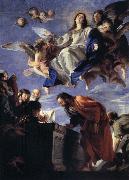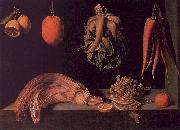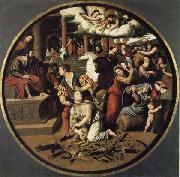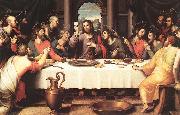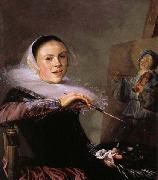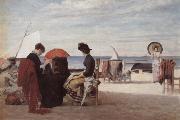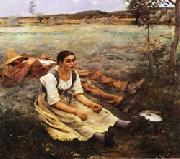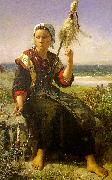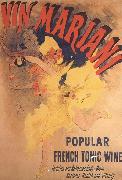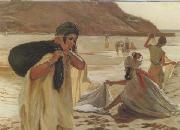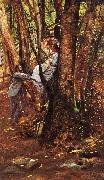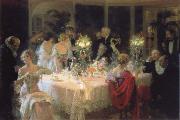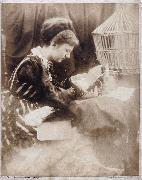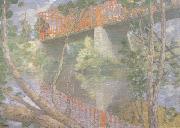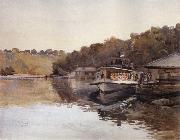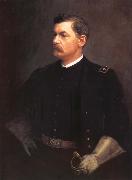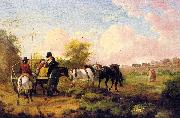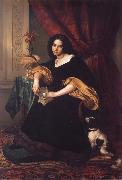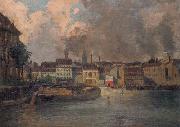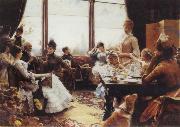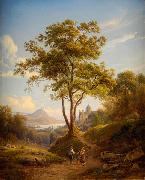|
|
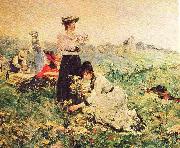 |
Juan Luna
|
|
Juan Luna y Novicio (October 23, 1857 - December 7, 1899) was an Ilocano Filipino painter, sculptor and a political activist of the Philippine Revolution during the late 19th century. He became one of the first recognized Philippine artists.
His winning the gold medal in the 1884 Madrid Exposition of Fine Arts, along with the silver win of fellow Filipino painter Felix Resurreccien Hidalgo, prompted a celebration which was a major highlight in the memoirs of members of the Propaganda Movement, with the fellow Ilustrados toasting to the two painters' good health and citing their win as evidence that Filipinos and Spaniards were equals.
Regarded for work done in the manner of the Spanish and French academies of his time, Luna painted literary and historical scenes, some with an underscore of political commentary. |
|
 |
Juan Manuel Blanes
|
|
(June 8, 1830 - April 15, 1901) was a noted Uruguayan painter of the Realist school.
Blanes was born in Montevideo, Uruguay, in 1830. He was raised by his mother, with whom he relocated to the countryside in his early teens. Blanes took an interest in drawing at this point, and shortly afterwards, was hired as an illustrator for a Montevideo newsdaily, El Defensor de la Independencia Americana. Earning extra income with watercolors, he returned to his mother and, in 1854, established his first atelier.
He married Marea Linari, and in 1855, the couple settled in Salto, where he worked as a portrait painter. They relocated to Concepcien del Uruguay (across the Uruguay River, in Argentina) in 1857, and Blanes was commissioned by Argentine President Justo Jose de Urquiza to complete a number of portraits, allegories and landscapes to grace his nearby estancia, the Palacio San Jose. Returning to Montevideo in 1861, the talented painter obtained a scholarship from the Uruguayan government, and with it, traveled with his family to Florence, Italy, where he studied under Antonio Ciseri until 1864.
The experience became a valuable calling card for Blanes, who became of Uruguay's most sought-after portraiteurs. The 1871 outbreak of a yellow fever epidemic in Buenos Aires inspired his first renowned work, which he exhibited to acclaim in the recovering city. His 1872 portrait of the Argentine War of Independence hero, General Jose de San Marten (The Review in Rancagua), was also a success in Buenos Aires, and Blanes was invited to Chile to display the historic depiction. |
|
|
|
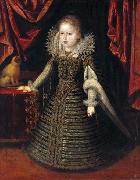 |
Juan Pantoja de la Cruz
|
|
(Valladolid, 1553 - 26 October 1608, Madrid) Spanish painter, one of the best representatives of the Spanish school of court painters. He worked for Philip II and Philip III. The Museo del Prado contains examples of his severe portraiture style.
Juan Pantoja de La Cruz was, born 1553 in Valladolid. Very little is known of his formative years as a painter. He was a pupil of the court painter Alonso Senchez Coello in Madrid and he must have assisted his master in complying with his duties as painter of the Spanish King, Philip II. Pantoja probably continued to work in his master studio after completing his training. He married in 1585 beginning to paint for the court around that time. After Sanchez Coello's death in 1588, Pantoja took over his master workshop and became court painter to Philip II of Spain.
Pantoja kept working for the court and the nobility, painting portraits of Prince Philip, the future Philip III, in 1592 and 1594. Among his most well known works is the portrait of Philip II wearing a cape and hat all in black, painted around 1594 for the Escorial. This portrait is one of the best representations of the idea of Spanish majesty, based on the remoteness of the monarch. On Philip II's death in 1598, Philip III confirmed Pantoja's status as court painter. When the court settled in Valladolid in 1601, Pantoja moved to the new capital, remaining in this city, several years. |
|
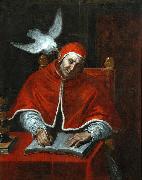 |
Juan Rizi
|
|
was a Spanish painter of the Baroque period. He was born in Madrid in 1600. He was a brother of Francisco Rizi, and a pupil of Juan Bautista Mayno. In 1628 he entered the Benedictine Order, studied in Salamanca, and became Abbot of the Medina del Campo in Madrid (?).
He painted several works for St. Juan Bautista in Burgos, St. Martin in Madrid, and Monte Cassino in Italy. In the Madrid Museum is a St. Francis of Assisi by him (?). He afterwards went to Rome, where he was made an Archbishop (?) by pope Clement X. He died at Monte Cassino in 1681.
|
|
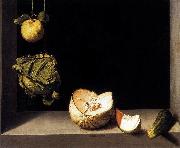 |
Juan Sanchez Cotan
|
|
(June 25, 1560 - September 8, 1627) was a Spanish Baroque painter, a pioneer of realism in Spain. His still lifes, also called bodegones were painted in a strikingly austere style, especially when compared to similar works in Netherlands and Italy.
Senchez Coten was born in the town of Orgaz, near Toledo, Spain. He was a friend and perhaps pupil of Blas de Prado, an artist famous for his still lifes whose mannerist style with touches of realism, the disciple developed further. Cotan began by painting altar pieces and religious works. For approximately twenty years, he pursued a successful career in Toledo as an artist, patronized by the city's aristocracy, painting religious scenes, portraits and still lifes. These paintings found a receptive audience among the educated intellectuals of Toledo society. Senchez Cotan executed his notable still lifes around the turn of the seventeenth century, before the end of his secular life. An example (seen above) is Quince, Cabbage, Melon and Cucumber (1602, in the San Diego Museum of Art).
On August 10, 1603, Juan Sanchez Cotan, then in his forties, closed up his workshop at Toledo to renounce the world and enter the Carthusian monastery Santa Maria de El Paular. He continued his career painting religious works with singular mysticism. In 1612 he was sent to the Granada Charterhouse, he decided to become a monk, and in the following year he entered the Carthusian monastery at Granada as a laybrother. The reasons for this are not clear, though such action was not unusual in Cotan's day. |
|
|
|
|
|
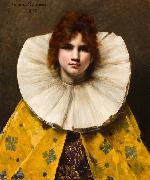 |
Juana Romani
|
|
was an Italian painter, student and model of Ferdinand Roybet and Jean-Jacques Henner.
Romani was born in Velletri, near Rome in Italy, but moved with her family to France as a child.
|
|
|
|
|
|
|
|
|
|
|
|
|
|
|
|
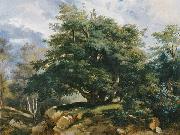 |
Jules Coignet
|
|
was born in Paris in 1798 and died there in 1860. He was a noted landscape painter who had studied under Jean-Victor Bertin. He travelled a good deal in his own country as well as elsewhere in Europe and the East, and produced a considerable number of views. A regular exhibitor at the Paris Salon exhibitions, he was awarded a gold medal there in 1824 and was given state recognition by being made a Chevalier of the Legion of Honour in 1836.
As a painter, Coignet holds a middle place between the Idealists and the Realists, and his work is remarkable for the combination of vigour and delicacy in the effects of light and shade, for poetical feeling, for a firm brush, and occasionally for grandeur of conception. This is particularly evident in "The Ruins of the Temple of Paestum", now in Munich's Neue Pinakothek.There are times too when his paintings have an atmospheric, almost Impressionist effect. One example is the coastal sunset in the Louvre; another is the pastel "Grey weather over the sea" (1848) in the Dijon museum.
Following the 1824 exhibition in Paris of John Constable's paintings, Coignet began painting outside in the forest of Fontainbleau and encouraged his students to do the same. One of his specialities was painting tree 'portraits', of which there are many examples, both as finished paintings and as sketches in oil paint. |
|
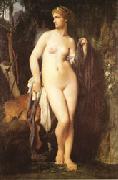 |
Jules Elie Delaunay
|
|
Nantes 1828 - Paris 1891.
French Neoclassical Painter.
Studied under Hippolyte Flandrin. |
|
|
|
 |
Jules Guerin
|
|
Mural painter and Illustrator.
American
1866-1946
|
|
 |
Jules Joseph Lefebvre
|
|
(Tournan-en-Brie, Seine-et-Marne, 14 March 1836 - Paris, 24 February 1911) was a French figure painter.
Lefebvre entered the École nationale superieure des Beaux-Arts in 1852 and was a pupil of Leon Cogniet. He won the prestigious Prix de Rome in 1861. Between 1855 and 1898, he exhibited 72 portraits in the Paris Salon. In 1891, he became a member of the French Academie des Beaux-Arts.
He was an instructor at the Academie Julian in Paris. He is chiefly important as an excellent and sympathetic teacher who numbered many Americans among his 1500 or more pupils. Some of his famous students were the Scottish-born landscape painter William Hart, as long as Georges Rochegrosse, Felix Vallotton, and many more. He was long a professor at the École des Beaux-Arts.
Many of his paintings are single figures of beautiful women.
Among his best portraits were those of M. L. Reynaud and the Prince Imperial (1874). Among his many decorations were a first-class medal at the Paris Exhibition of 1878 and the medal of honor in 1886. He was a Commander of the Legion of Honor and a member of the Institut de France.
|
|
 |
Jules Lefebvre
|
|
Tournan-en-Brie, 1834-Paris 1912.
French Academic Painter. |
|
 |
Jules Pascin
|
|
Bulgarian-born French Expressionist Painter, 1885-1930 |
|
|
|
|
|
|
|
|
|
|
|
|
|
|
|
|
|
|
|
 |
Julian Falat
|
|
(30 July 1853 in Tuligłowy near Lwew - 9 July 1929 in Bystra Śląska) was one of the most prolific Polish painters of watercolor and one of the country's foremost landscape painters as well as one of the leading Polish impressionists. Fałat first studied under Władysław Łuszczkiewicz at the Krakew School of Fine Arts, and then at the Art Academy of Munich. After several trips throughout Europe and Asia in 1885, Fałat compiled a collection of studies from his voyages which would become useful later in the development of his artwork. Themes typical of Fałat's painting are Polish landscapes, hunting scenes, portraits, and studies from his voyages. In 1886, Fałat accepted an invitation from future German Emperor Wilhelm II to serve as court painter in Berlin.
Fałat died in Bystra Śląska on July 9, 1929. A museum in Poland, called Fałatewka, is devoted to him.
Out of his three children, Kazimierz (Togo) (1904-1981) continued to paint in watercolour.
Some works, having been looted under German occupation, very occasionally reappear in sales-rooms. Later works, produced after he settled in England, are largely in the hands of his later family. |
|
 |
Julian Falat
|
|
Julian Falat, (30 July 1853 in Tuliglowy near Lwow - 9 July 1929 in Bystra Sląska) was one of the most prolific Polish painters of watercolor and one of the country's foremost landscape painters as well as one of the leading Polish impressionists. Falat first studied under Wladysław Luszczkiewicz at the Krakow School of Fine Arts, and then at the Art Academy of Munich. After several trips throughout Europe and Asia in 1885, Fałat compiled a collection of studies from his voyages which would become useful later in the development of his artwork. Themes typical of Fałat's painting are Polish landscapes, hunting scenes, portraits, and studies from his voyages. In 1886, Falat accepted an invitation from future German Emperor Wilhelm II to serve as court painter in Berlin.
Falat died in Bystra Sląska on July 9, 1929. A museum in Poland, called Falatowka, is devoted to him.
Out of his three children, Kazimierz (Togo) (1904-1981) continued to paint in watercolour. |
|
 |
Julian Falat
|
|
(30 July 1853 in Tuligłowy near Lwew - 9 July 1929 in Bystra Śląska) was one of the most prolific Polish painters of watercolor and one of the country's foremost landscape painters as well as one of the leading Polish impressionists. Fałat first studied under Władysław Łuszczkiewicz at the Krakew School of Fine Arts, and then at the Art Academy of Munich. After several trips throughout Europe and Asia in 1885, Fałat compiled a collection of studies from his voyages which would become useful later in the development of his artwork. Themes typical of Fałat's painting are Polish landscapes, hunting scenes, portraits, and studies from his voyages. In 1886, Fałat accepted an invitation from future German Emperor Wilhelm II to serve as court painter in Berlin.
Fałat died in Bystra Śląska on July 9, 1929. A museum in Poland, called Fałatewka, is devoted to him.
Out of his three children, Kazimierz (Togo) (1904-1981) continued to paint in watercolour.
Some works, having been looted under German occupation, very occasionally reappear in sales-rooms. In December 2010, two such paintings, "The Hunt" and "Off to the Hunt" were seized by U.S. authorities from auction houses in New York City. The works are to be repatriated to Poland's National Museum of Art in Warsaw. Later works, produced after he settled in England, are largely in the hands of his later family.
|
|
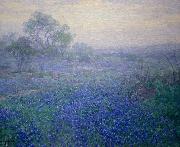 |
Julian Onderdonk
|
|
(July 30, 1882 - October 27, 1922) was a Texan Impressionist painter, often called "the father of Texas painting."
Julian Onderdonk was born in San Antonio, Texas, to Robert Jenkins Onderdonk, a painter, and Emily Gould Onderdonk. He was raised in South Texas and was an enthusiastic sketcher and painter. As a teenager Onderdonk was influenced and received some training from the prominent Texas artist Verner Moore White who also lived in San Antonio at the time. He attended the West Texas Military Academy, graduating in 1900.
At 19, with the help of a generous neighbor, Julian left Texas in order to study with the renowned American Impressionist William Merritt Chase. Julian's father, Robert, has also once studied with Chase. Julian spent the summer of 1901 on Long Island at Chase's Shinnecock School of Art. He studied with Chase for a couple of years and then moved to New York City to attempt to make a living as an en plein air artist. While in New York he met and married Gertrude Shipman and they soon had a son.
Onderdonk returned to San Antonio in 1909, where he produced his best work. His most popular subjects were bluebonnet landscapes. Onderdonk died on October 27, 1922 in San Antonio.
President George W. Bush decorated the Oval Office with three of Onderdonk's paintings. The Dallas Museum of Art has several rooms dedicated exclusively to Onderdonk's work.
|
|
|
|
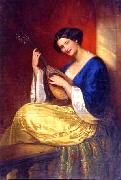 |
Julie Wilhelmine Hagen-Schwarz
|
|
(born October 27, 1824 near Tartu - died Tartu October 7, 1902) was an Estonian painter of Baltic German origin. She studied in Dresden with Friedrich Gonne and later in Munich with Johann Moritz Rugendas. |
|
|
|
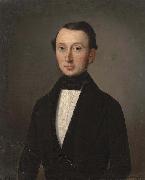 |
Julien Hudson
|
|
(1811-1844) was a 19th Century free man of color who lived in New Orleans. He was a successful painter and art teacher. He is known as the first African American or French Creole of Color operating in America by whom a self-portrait was found. |
|
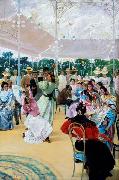 |
Julio Romero de Torres
|
|
was a Spanish painter.
He was born and died in Cerdoba, Spain, where he lived most of his life. His father was the famous painter Rafael Romero Barros and his mother was Rosario de Torres Delgado. Julio learned about art from his father who was the director, curator and founder of Cerdoba's Museo Provincial de Bellas Artes and an impressionist painter. He took an interest in art at a young age and started studying at the School of Fine Arts when he was 10. He went to Madrid to work and study in 1906. He also traveled all over Europe to study and he picked up a symbolist style, for which he is best known. A museum dedicated to the work of de Torres is situated at Plaza del Potro 1 Cordoba 14002.
He spent most of his life living in Cerdoba and Madrid and both places had influences on his paintings. He combined many different styles when he painted because he had many different influences including realism, which was a popular style at that time and impressionism, which he picked up from living in Cerdoba and from his father. While in Cerdoba he became part of the late 19th century intellectual movement that was based on the Royal Academy of Science, Arts and Literature. Julio Romero also won many awards in his lifetime. In 1895 he won an honorable mention at the National Exhibition and later won third place in 1899 and 1904.
El Retablo del Amor by Julio Romero de Torres, painted in 1910.In 1914 he relocates to Madrid, where he makes contact with the intellectual and artistic environment of the time together with his brother Enrique. He became a regular at the cafe Nuevo Levante and his paintings began to reflect the philosophical currents of the times, represented by such writers of the times as Ramen del Valle-Inclen and Ruben Dareo. When the war broke out in 1914 Julio Romero fought for the allies as a pilot
|
|
|
|
|
|
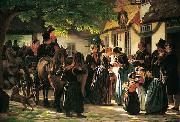 |
Julius Exner
|
|
(November 30, 1825-November 15, 1910), Danish genre painter, was born in Copenhagen to Johann Gottlieb Exner, a Czech musician from Bohemia, who came to Denmark during the Napoleonic period, and his wife Karen Jørgensdatter. Exner originally intended on becoming a history painter, but quickly found his niche, however, in genre painting, the most popular and lucrative painting style of his era. |
|
 |
Julius Grun
|
|
Julius Gren (1823-1896)Aliases: Gustav Julius GrenProfessions: Porträtmaler; Genre Painter; Historical-scenes painter. |
|
|
|
|
|
|
|
|
|
|
|
|









